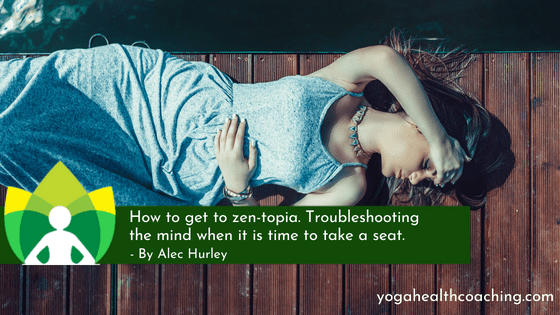
How to get to zen-topia. Troubleshooting the mind when it is time to take a seat.
So you sit down for your meditation practice after a long day with the hopes that your mind will quiet down. After a few moments you quietly ask yourself, Is it even possible right now? Your inner dialogue continues. Is that possible? I don’t think it will ever stop.. I should have ordered the fish tacos, they looked really good. …How long have I been sitting here?… If you have ever tried meditation then you may have come across a similar inner dialogue at some point. I know I have and still do! Meditation yields many benefits but can be really hard to have as a daily practice. Here are a few tips on what I have learned along my path to cultivating my inner stillness and becoming one who meditates.
There are many paths to this place of stillness, but first of all, what is stillness? To the beginner, it may seem like the elusive state of mind that you read about in the ancient spiritual texts. To the novice, it may be a glorious state of calm that is reached every so often. To the seasoned meditator, it is a state of being, the state that scientists of the highest caliber are studying. So how would one turn off the mind and find their way into this place of stillness? Well for starters the mind is a thinking machine. And behind this thinking machine are the subtle layers of clarity. Some lineages of meditation have called these layers the “clear light mind” while others have referred to it as the “seat of the observer”. This is the place of stillness beyond your senses, void of thoughts, emotions, and beliefs.
Our minds love to wander, don’t they? Sometimes you may feel that you can’t sit still, or your mind won’t stop. This could be from stress, overwhelm and/or not processing a portion of your inner dialogue, emotions and experiences. That was my experience.
So how does it work and how can you learn to experience this state even when the mind is reflecting a relentless hungry child? Let’s explore two practices I have adopted to help continue a meditation practice and cultivate inner peace.
Two meditative practices that help you find your zen.
- Mind wandering.
I have discovered that during my day, my mind becomes overwhelmed and then fatigued. Meditation is a great place for me to find some rejuvenation from this fatigue, and this is my strategy to enhance the practice. Through trial and error, when I sit on my cushion to meditate, the mental fatigue would keep my mind very active and easily distracted. So I tried pulsing between focus and freedom — focusing my mind for as long as possible and then allowing it to wander. I liken this to exercising a muscle, it is the strengthening and releasing that builds strength and resilience.
This is a particularly easy way to zentopia and a very popular route to spark creativity and thinking outside of the box. If you find yourself trying to hard or having a hard time staying focused, mind wandering can be a great tool to troubleshoot an overactive mind. It is like letting the dog off the leash in a park. After running, sniffing and exploring every scent and corner of the park, it calms down and begins to rest in the tranquility of being.
Life can be very heavy and stressful, so inviting lightness into your practice can leave you feeling refreshed to keep you coming back for more. What I have found during those times the mind just wants to lick every thought and eat every sensation, let it! Let it go for a few minutes and tire itself out. You will see that after a few minutes of running wild it is much easier to go deeper into your inner zen-den and find the calm seat behind the chaotic mind.
- Explore the senses.
Your senses are interpreters of your world. When overstimulated they can become dull and, well, desensitized. The act of moving your awareness through the senses helps to calibrate the senses and calm the mind. To do this, grab a timer and set it for 2-3 minutes. During that time fix your attention on one sense. For example:

- When you are fixed on the sense of smell, focus on the smells around you and notice them as they are. Experience the smell or lack thereof without labeling or judgment.
- Explore the different sounds happening from all directions. The sounds near to you, and far from you, receiving them as they come.
- Soften your gaze on a stationary object and look at it. Without trying to focus on the object itself, continually let go of the need to focus and relax the eyes.
- Feel all of the things touching your skin, clothes, floor and even air temperature. Feel the contrast between all of the sensations. For example, cool and warm, soft and firm.
- Notice the tastes in your mouth. Without preference to change anything, accept the flavors as they are in the moment.
Technically this is an alternating concentration practice and is a great warm-up for the longer single-pointed focus practices. It is highly effective because it promotes concentration while calming the senses and organs of action.
While a meditation technique such as single-pointed focus (or dharana) is a powerful step along your path to inner peace, these two practices can be helpful strategies when your meditations could use a little help. It is still a great idea to find a quiet time with the intention to focus the mind. The practice of focus and concentration helps find balance in the overstimulating world we live in and helps to cultivate strong mental focus, presence and bodily awareness.
I think of meditation as shifting to be a state of being more than a practice itself, so enjoy your journey to zen-topia and choose a meditative practice that suits your needs in the moment.



